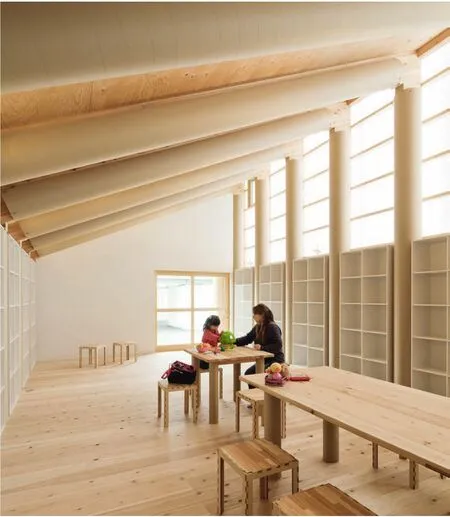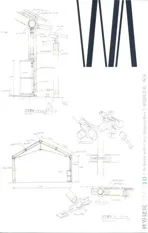集装箱临时住宅,女川, 日本
2014-02-20建筑设计坂茂建筑事务所
建筑设计:坂茂建筑事务所
集装箱临时住宅,女川, 日本
建筑设计:坂茂建筑事务所

1 夜景/Night view
自2011年3月11日日本东北大地震以来,我们已经考察了50多个纸制隔断体系(PPS)的避难设施,总计1800多个2m×2m单元的户间私密性。当时,我听说女川町由于缺少平地,无法建造足够的临时住宅。因此我们提出用货运集装箱建造3层的临时住宅。棋盘式的交错布置体系在这些集装箱之间营造出开敞明亮的生活空间。政府提供的标准临时住宅质量较差,储物空间也不足。在志愿者和善款的帮助下,我们的住宅全部安装了内置的橱柜和架子。这一创新将成为政府避难设施和临时住宅新标准的范本。
集装箱临时住宅的特点
临时住宅已开始用于灾区,不过数量仍供不应求。一个主要原因是大部分受灾的滨海区地势不平。由于临时住宅通常适用于平地,所以要提供所需的户数十分困难。我们在宫城县女川町把现成的货运集装箱(约6m高/20英尺)以棋盘式叠成住宅,最高3层。
集装箱临时住宅的特点是:利用现成集装箱可以缩短施工时间;宽敞的间隔可以为停车场、社区设施及各户的私密性提供便利;棋盘式的布局能够在户间营造开敞的生活空间;良好的抗震性能;可作为永久公寓使用。
户型平面
户型根据货运集装箱的布置可分为3种:19.8m2、29.7m2和39.6m2。19.8m2供单人或双人居住,29.7m2为3~4人,39.6m2是4人以上。
纸造画室
这个画室是日本画家千住博为捐给宫城县女川町而设计的。叠置集装箱临时住宅建在原有的一座棒球场上。坡形的结构框架是由直径336mm的纸筒和木节点组成的。10个框架间隔1.2m。框架之间是架子,既可用于储物也可用于陈列。这些架子的背板可以避免框架变形。画室的外表面为聚碳酸酯瓦楞板。北立面上有高侧窗提供柔和的自然光。
社区中心
现场叠置的集装箱临时住宅带来的大间距为社区中心的设计提供了可能性。与临时住宅的6m高的集装箱一样,社区中心两侧各有一个集装箱,分别是设备间和仓库。两个集装箱之间架起一个木屋顶,可以同时容纳70人就座。天花板为日本柳杉,地板来自宫城县本地。(尚晋 译)
Since the 3.11 earthquake, we have visited more than 50 evacuation facilities with 1800 units of 2m × 2m with family privacy. During that time, I learned that Onagawa had difficulty in constructing enough temporary shelters due to the lack of flat land. Therefore, we proposed threestory temporary residential buildings made from shipping containers. By stacking these containers in a checkerboard fashion, bright open living spaces were created between the containers. The standard temporary housing provided by the government was of poor quality and there was not enough storage space. We installed built-in closets and shelves in all of our houses with the help of volunteers and with the donation fund. It will become an example of new standards for the evacuation facilities and temporary housing provided by the government.
The Characteristics of Temporary Container Housing
Temporary housing has been deployed in disaster areas. However, the amount of housing is insufficient. The main reason is that most of the damaged coastal areas are not flat lands. As temporary housing is suitable for flat lands, it is difficult provide the numbers of unit needed. In Onagawa, Miyagi prefecture we built residential buildings by stacking existing shipping containers (about 6.1 meters or 20 feet high) in a checkerboard pattern up to three stories.
The characteristics of temporary container housing: Shortening the construction period by usage of existing containers; the wide space between buildings can be used as parking lots, community facility and privacy of families are ensured; open living space can be obtained in the checkerboard pattern; having excellent seismic performance; can be used as a permanent apartment building.
Unit plan
There are three types of plans, 19.82, 29.72and 39.62. 19.82is for one or two residents, 29.72for three to four and 39.62for more than four.
Paper Atelier
This atelier is designed to be donated to Onagawa, Miyagi prefecture, by Japanese painter Hiroshi Senju. The temporary container housing is located in an existing baseball field. The sloped structural frame is composed of wood joints and paper tubes with a diameter of 336mm. Ten frameworks are spaced 1.2m apart. Between the frames there are shelves, which can be used for storage as well as for display. The backboard of the shelves prevents deformation of the frame. Corrugated polycarbonate sheets make up the exterior of the atelier, with clerestory along the north facade to allow soft and natural light to get in.
Community Center
By stacking the temporary container housing on site, wide spacing is achieved for the community center. Similar to the 20 foot containers of the temporary housing, two containers are placed on either side of the community center, which serve as mechanical and storage spaces. Between the containers a wooden roof structure is constructed, which provides seating for 70 people. The Japanese cedar wood is used for the ceiling and the floor came from Miyagi prefecture.
项目信息/Credits and Data
项目团队/Project Team: Shigeru Ban, Nobutaka Hiraga,
Jun Matsumori, Yasunori Harano, Reiji Watabe, Voluntary Architects' Network
结构设计/Structural Engineers: Arup
设备设计/Mechanical Engineers: TSP Taiyo Inc.
总承建方/General Contractor: TSP Taiyo Inc.
建成时间/Construction Period: 2011.11
摄影/Photos: Hiroyuki Hirai

2 19.8m2户型/19.8m2type

3 29.7 m2户型/29.7 m2type

4 39.6 m2户型/39.6 m2type

5 市场/Market

6 分解示意/Exploded diagram

7 轴测/Axonometric view
评论
刘彤彤:这个作品可以是“建造的关爱”的最佳注脚。本案最可贵之处,是在灾后临时住宅有限的空间内,确保居住者的私密性,并尽可能提升居住的品质。作品中倾注的不仅是高超的专业技巧,更有对使用者的无尽关怀。建筑师不再是高高在上的施予者;他提供的也不再是遮风避雨的庇护所,而是可以容纳尊严、隐私,充满希望的生活空间。
柳亦春:哪里有地震,哪里就有坂茂。灾难将我们逼回了对生存基本保障的空间的思考,安全、快速、心理抚慰……工业用的集装箱适应了快速建造的需求,有效的切割令空间变得开敞,满足了较好的居住质量。坂茂的纸管轻型建造系统虽然并不适宜于大量性的建造,却能够在灾难面前承担心灵庇护所的角色,因为它绝对地轻,温暖、圆柔,给灾难后的人们以安全感,建筑学得以抛开任何历史的羁绊,回到对基本建造所带来的关于庇护的价值的讨论。
Comments
LIU Tongtong: This work could be the best footnote for "To Build with Care". The biggest highlight of this design is to ensure privacy between families in the limited space of temporary housing, and to raise the living quality for its residents. Super professional skills are poured into the design, as well as endless caring for its residents. Here the architect is no longer a superior "almsgiver". What he offers is also no longer a shelter from the storm, but a living space full of hope, a space in which dignity and privacy can be contained.
LIU Yichun: Wherever there is an earthquake, there will be Shigeru Ban. Disasters force us to reflect on the basic requirements a living space, such as security, speed, and psychological consolation. While shipping containers satisfy the needs of quick construction, effective cutting opens up spaces and allows a better quality of life. Although Shigeru Ban's light paper tube structural system is not suitable for mass production, it fulfills the role of a "heart shelter" in face of disaster, for it is absolutely light, warm, round, soft, and able to give people a sense of security after their suffers. In this way, architecture is able to break away from the fetter of history and return to the discussions on the values of shelter brought about by basic construction.
Container Temporary Housing, Onagawa, Japan, 2011
Architects: Shigeru Ban Architects

8.9 内景/Interior view

10 社区中心外景/Community center exterior

11 社区中心内景/Community center interior

12 纸造画室外景/Atelier exterior

13 纸造画室内景/Atelier interior

14 市场开业典礼/Market at opening ceremony

15 市场内景/Market interior
